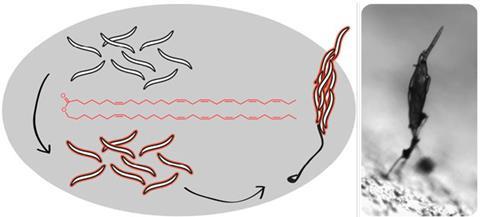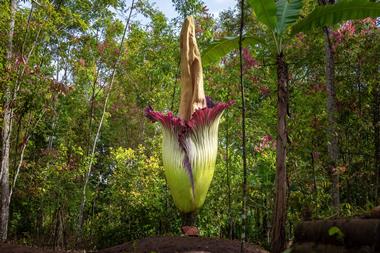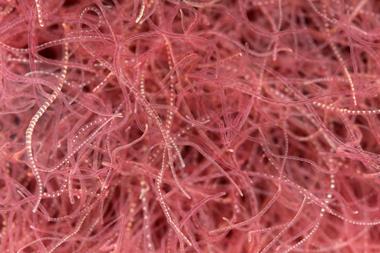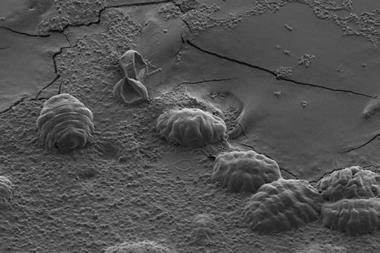A species of nematode worm has evolved an extraordinary means of getting about, according to a team of researchers in Germany. They’ve discovered that, in response to stress, such as heat or scarce food, the microscopic larval worms, typically just 5µm long, secrete an adhesive wax which enables them to build ‘towers’ of up to 1000 individuals by climbing on top of each other. These towers protrude from the surface on which the worms sit, and the worms wiggle so as to make the whole tower wave or ‘nictate’. This increases the chances that the worms might become attached to another host organism and find pastures greener.
Pristionchus pacificus is a nematode parasite that survives by attaching itself to a scarab beetle, waiting for the beetle to die and then feeding off the rotting corpse. While they wait for this food supply, the young worms can arrest their development at the larval stage and enter a low metabolism resting form called a dauer, which can survive for months without food. P. pacificus often switches to a new host while in the dauer stage, and does so by nictation: standing on its tail and waving.
But the chances of hitching a ride, say Teymuras Kurzchalia of the Max Planck Institute for Molecular Cell Biology and Genetics in Germany and co-workers, are increased by forming ‘dauer towers’, which can extend up to 1cm from the beetle. The towers themselves seem to be built on protrusions, such as the appendages of beetle larvae or the bristles of grubs. ‘Having observed the towers in culture, we decided to test whether dauer larvae on the carcasses of insect hosts can form towers,’ says author Sider Penkov. And they could.
Tower power
These structures are robust enough to survive prodding. But the researchers found that they would dissolve, freeing the individual larvae, when placed in detergents or organic solvents, suggesting that the ‘glue’ is some kind of hydrophobic material. Further investigation revealed that the dauer larvae secrete droplets of a lipid on their surface, and they extracted this lipid into hexane and purified it using chromatography. It forms a colourless oil that the team calls nematoil. Using NMR spectroscopy, Kurzchalia’s collaborator Hans-Joachim Knölker of the Technical University of Dresden, Germany, deduced that the oil is a very long chain unsaturated wax ester, consisting of two C30 chains linked via an oxygen atom. This makes nematoil one of the longest known natural waxes. Knölker and his team confirmed the structure by synthesising the compound from scratch using commercial reagents.

Toyoshi Yoshiga, a nematode specialist at Saga University in Japan, says that it was suspected that Pristionchus might make a sticky, hydrophobic coating like this. ‘Stickiness is one of the striking features of the dauer larvae,’ he says. ‘They also float on water. Usually, nematodes sink in water but as far as I know only dauer larvae of Pristionchus can float.’
Making such a big lipid compound would involve a considerable investment of energy for the nematode, and so the formation of dauer towers using this adhesive must be an effective survival mechanism to make it worthwhile. Each of the two chain segments contains a series of five carbon–carbon double bonds separated by a CH2 group, and this unsaturation keeps the nematoil fluid, which allows it to act as a sticky coat without hampering the movements of the larvae. Kurzchalia and colleagues suggest that it might also act as a water barrier to protect the larvae from desiccation.
Making a dauer tower requires a fair degree of coordination between the worms. The researchers don’t know yet how that is achieved, but they think it may involve some kind of chemical signalling – as is the case in the slime mould Dictyostelium discoiseum, for example, where the single-celled organisms can aggregate into complicated mushroom-shaped ‘fruiting bodies’ in times of stress. Yoshiga thinks that such swarming behaviour might be quite common in nematodes, and says he has seen similar aggregation in the nematode Caenorhabditis japonica. ‘The plant parasitic nematodes Ditylenchus dipsaci swarm to form clumps known as “eelworm wool”,’ he adds.















No comments yet